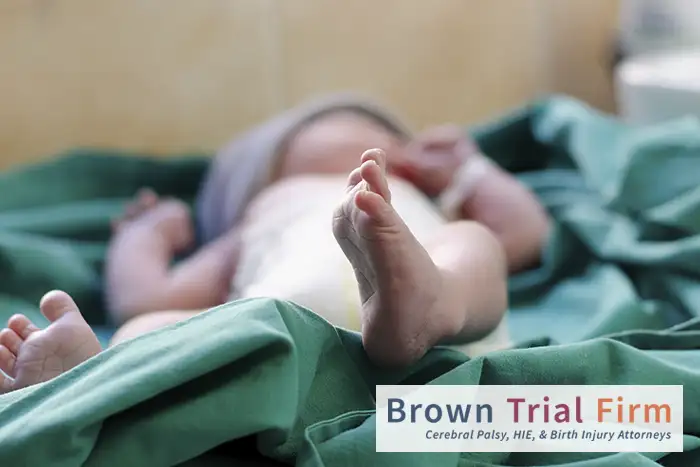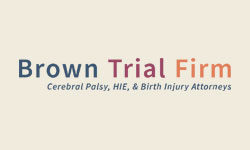A significant number of children with cerebral palsy suffered a birth injury as a result of complications encountered during labor and delivery.
Cerebral Palsy is a condition that can have a range of seriousness. It can be relatively mild – where there’s mild physical impact and mild cognitive thinking impact – to severe. A child who is severely affected with cerebral palsy can be wheelchair-bound, can have lots of significant physical limitations, as well as cognitive limitations.
If the child’s cerebral palsy was caused by lack of oxygen at the time of labor delivery by trauma during delivery – if it relates to a medical mistake – then what we as lawyers who represent children with these disabilities can do is prepare and develop a case to recover what is necessary to take care of that child’s future -and that is going to include medical care.
These children require a lot of medical care depending on the degree of injury; it’s going to include rehabilitation and therapies to help them with the physical disabilities that they have and then it may include later healthcare for when the parents can’t be there 24 hours a day and sometimes when the parents are too old to continue to care for the child – because that child will grow, and develop, and age as a normal child would. So, if you have a child that has been diagnosed with cerebral palsy and you have questions about if it was caused by a medical mistake and what’s going to be necessary to take care of this child for the rest of his life – contact our firm and we’ll be happy to talk with you about what we can do to help in analyzing the situation and in taking care of your child.
When something goes wrong during labor and delivery, parents are not always told the significance and may not understand that their child has suffered a severe injury with lasting consequences. There are tests that can be run to gather information about the cause and extent of the potential damage, and having this information as early as possible can be very important in obtaining proper medical treatment to minimize damage to the baby’s brain.
Many times, the extent of the damage becomes more apparent later on. If the child is delayed or does not reach “normal” developmental milestones, that may indicate a brain injury and predict future developmental problems. A diagnosis of a birth injury like cerebral palsy is usually not made at the time of birth, but later in the child’s development as the physical and cognitive deficits become more apparent.
“They went above and beyond to give our family a level of closure that was vital for us to move forward...” - Della C.
“They worked their hearts out to get justice for a young child...I have been a lawyer for 20 years, and can honestly say that this law firm could be the best medical malpractice firm in the country.” - Reynaldo Garza III
lawyer
“I will definitely recommend them to any family. Laura is definitely hands down an amazing lawyer.” - Jacklyn C.
After a diagnosis of cerebral palsy, early intervention and treatment could make a significant difference in your child’s future quality of life. As a parent, you’re undoubtedly concerned about providing the best care that your child deserves—both now and in the future. For this reason, it’s important to speak with a birth injury attorney or cerebral palsy lawyer as soon as possible after diagnosis to determine if your child has a medical malpractice claim and needs legal protection.
If your baby was recently diagnosed with cerebral palsy and you have questions, we can help you get answers. At Brown Trial Firm, we’ve devoted our entire practice to fighting for accountability and responsibility for preventable birth injuries. Doctors and hospitals have deep pockets and expensive lawyers at their disposal. We help even the playing field for patients by exclusively representing babies and their families. We’re ready and willing to go up against even the largest hospital corporations or insurance companies. Years of devoted practice have instilled us with confidence, experience and the skills to match.
We serve families nationwide.
Have questions about a birth injury?
Was your child’s CP caused by malpractice?
Some birth injuries that result in cerebral palsy could have been prevented, but not all.
So how do you know if your child’s CP was caused by medical malpractice?
Think about your labor and delivery.
A lack of attentiveness during delivery is one of many possible indications of malpractice. Or perhaps an administrative error prevented a provider from being aware of a medical condition in the mother or the fetus. Additionally, medical professionals may fail to detect fetal distress signals during the later months of the pregnancy or during birth.
You may have questions about whether or not your child’s cerebral palsy is the result of medical negligence. At Brown Trial Firm, we will listen to you carefully and determine if we think your child’s brain damage is the result of a medical error or negligence.
Hypothermia Therapy for Brain-Injured Babies
Even though neonatal cooling therapy is a widely proven and generally accepted treatment for newborns experiencing HIE, it’s important for medical providers to carefully follow strict procedures and steps to ensure the effectiveness of the therapy and avoid potential negative impacts.
Failure to follow these procedures can negate the treatment and cause further injury.
Is a birth injury case worth the cost and hassle?
Lawsuits are expensive. This is true. Plus, parents of a child with cerebral palsy may be barely scraping by and can’t imagine spending time and effort pursuing legal action at this time. You might be feeling hopeless and wondering:
Should I even bother talking with a birth injury lawyer?
We believe the answer to this question is yes, and here’s why:
Our birth injury attorneys can ease your stress and financial burdens by helping secure compensation for your child’s medical costs, including:
- Past and future medical treatment
- Medical equipment and assistive devices
- Indirect costs, such as the inability to work
- Special education
- Home modifications
- Long-term home medical care
- Therapy and rehabilitation
At Brown Trial Firm, we understand that your time and money are valuable. Unlike other law firms that bill by the hour, we won’t charge you a dime out of pocket. We only get paid if we successfully recover on your case. If you ever disagree with any charge – no worries – just let us know and we can talk about it.
What is the process for filing a Cerebral Palsy birth injury lawsuit?
- Consultation. Your first step is to contact an experienced birth injury lawyer who can review the facts and help you decide whether or not to go forward with legal action. During this evaluation, your attorney should look at the details of your child’s CP diagnosis and decide if you could pursue a case.
- Filing a claim. In the event your lawyer believes you have a case, it’s time to start the filing process. At Brown Trial Firm, we usually begin by drafting and filing a petition to start your lawsuit.
- Discovery. Next, we exchange information about the case with the other side (known as the “discovery” process). Discovery is used to see what information the other side possesses.
- Depositions. We may then wish to take depositions. A deposition is a sworn testimony that helps us discover information a witness has that could be relevant to your case. For brain damage cases, the focus will be on what all involved parties know about the events that happened before, after and during the birth.
- Investigation. We’ll also consult with medical experts to evaluate the facts of your case. Medical experts are usually well-qualified nurses and doctors who have subject matter expertise related to birth injuries. These experts assist us in analyzing the facts about your case.
- Mediation. As birth injury cases come to a conclusion, many go to mediation. Mediation is an opportunity for both parties to meet in person outside of court to reach an agreement. In some cases, the case will settle out of court in mediation.
- Trial. If the case doesn’t settle in mediation, the next option is to go to trial. Our skilled trial lawyers will present your case to a judge or a jury, call medical experts and witnesses to testify and put your case in the hands of the jury.
It all starts with your free consultation. To find out whether you have a case, contact the Brown Trial Firm today and learn about your options.
Verdicts & Settlements Financial security for Your Child
Birth injury cases are like babies—every one is unique and special. Although these past success stories are no guarantee of success in your case, they can provide you examples of what we’ve been able to accomplish in similar cases. Contact us to determine the value of your potential claim.
HIE Malpractice Lawsuit
The child’s HIE and CP were caused by hypoxia and ischemia when the umbilical cord wrapped around the child’s neck, preventing the child from getting enough oxygen. The medical providers did not identify the warning signs and did not order a timely c-section. The delay caused severe and permanent injuries.
Cerebral Palsy Malpractice Lawsuit
The child suffered HIE and CP injuries when the medical professionals failed to timely order and perform a c-section in response to fetal distress warnings. A contingent (%) fee charged on the successful recovery resulted in a fee of $3,080,000 and litigation expenses and attorney’s fees which were reimbursed by the client out of the gross settlement amount.
Cerebral Palsy Malpractice Lawsuit
The child suffered HIE and CP as a result of uterine rupture, placental abruption, and a delay in performing an emergency c-section. A contingent (%) fee charged on the successful recovery resulted in a fee of $1,441,584 and litigation expenses and attorney’s fees which were reimbursed by the client out of the gross settlement amount.
Medical professionals have a duty of care towards their patients. Unfortunately, mistakes can sometimes lead to life-altering consequences, such as brain damage in a baby.
Learn more about how medical negligence can cause brain damage and how you can take legal action if you suspect neglect or malpractice.
We secured a $10.3 million medical malpractice verdict for the Ramirez family
At midnight on Friday, October 24, 2014, Ana Ramirez went into labor and the family went to the Valley Regional Medical Center in Brownsville, Texas. During labor, the charge nurse observed the baby’s heart rate dropping dangerously low on 2 occasions.
The charge nurse had been trained to call the doctor if she observed a low heart rate. But instead of calling the doctor, she chose to wait.
When the doctor was finally called, he sped to the hospital. He performed an emergency c-section delivery. The baby’s umbilical cord was wrapped twice around his neck—so tightly that the doctor had to cut the umbilical cord off to free the baby.
Because of the lack of oxygen, baby Mateo suffered serious brain injuries. The brain injuries resulted in spastic quadriplegia, a severe form of cerebral palsy. Mateo is unable to talk, walk, sit up or feed himself. He requires round-the-clock nursing care and will for the rest of his life.
On February 8, 2018, after hearing the evidence, the jury returned a verdict for $10.3 million for the child’s medical expenses. The Ramirez family is relieved that Mateo will receive the medical care he needs, and they hope that this case will prevent other children from being injured in the same way in the future.
The child, Mateo, suffered a devastating brain injury which was absolutely preventable had the nurses called the doctor to come to the hospital to see the mother. Watching Mateo’s mother when she heard the jury tell the hospital that it was clearly responsible and accountable for Mateo’s injuries, after this hospital had denied all responsibility, was one of the most powerful moments I’ve ever seen.
Birth Injury Attorney Laura Brown, lead counsel for the baby
What causes cerebral palsy?
All forms of cerebral palsy are the result of damage to the baby’s brain, often during pregnancy, at the time of labor and delivery, or shortly after birth. This brain damage is permanent but non-progressive, so the damage to the brain does not worsen over time. However, the clinical expression of the symptoms may change as the child grows and brain matures.
Often, brain damage is caused by a lack of oxygen to the baby’s brain during labor and delivery. Other causes of brain damage include trauma, premature birth and infection. Although some cases of cerebral palsy are not related to birth issues, an estimated 20 percent of all cases are the result of complications encountered during labor and delivery, many of which are preventable.
Medical staff, including nurses and doctors, are required to carefully monitor both mother and baby during labor and delivery. If the medical providers don’t pay attention or don’t act quickly when a problem arises, there may be lifelong consequences for the baby.
Medical negligence, including the failure to provide the accepted standard of care during labor and delivery, is one of the most common causes of permanent brain injury and cerebral palsy in children.
Lack of oxygen to the brain (hypoxic-ischemic encephalopathy, or HIE)
Lack of oxygen during labor and delivery is a significant cause of most types of cerebral palsy. The baby’s developing brain is especially sensitive to injury at this time. Before birth, the baby’s health depends on the mother. The mother delivers vital nutrients and oxygen to the baby through the blood that flows through the umbilical cord. The placenta regulates the exchange of oxygen, nutrients and carbon dioxide between the mother and the baby.
There are different events or complications which can deprive a baby of adequate oxygen. Here are some of the known complications that can cause injury to a baby’s brain and result in cerebral palsy:
One way to think about a baby’s oxygen supply is like an air tank for breathing underwater. Like a diver underwater, the baby can use their oxygen reserve to survive for a while without harm. However, if too much time passes, the oxygen reserve runs low, and a serious birth injury can occur. If there isn’t enough oxygen in the bloodstream, this is called “hypoxia.” If there isn’t enough blood flowing to the baby, this is called “ischemia.” When the baby doesn’t get enough oxygen, the baby’s tissues develop what is called “hypoxemia.”
There are several ways that the baby might not get enough oxygen. When an umbilical cord gets kinked or compressed shut, the baby may not get enough blood flow to have enough oxygen. When the uterus ruptures or the placenta tears away from the uterus, this can disrupt the flow of oxygen to the baby. Sometimes, even the contractions of the mother’s uterus can cause the baby to not get enough oxygen.
Asphyxia causes the development of lactic acid in the blood. The buildup of lactic acid causes acidosis. Acidosis is dangerous and damages brain cells and tissues. The medical diagnosis for this condition is called “hypoxic-ischemic encephalopathy” or HIE. When a baby has HIE, the brain damage is permanent. Permanent brain damage may cause the baby to have seizures, developmental delays and cerebral palsy.
Birth trauma
Trauma can cause injury to the baby’s brain. Some common causes of traumatic injury are injuries related to operative vaginal deliveries, such as:
- Vacuum extraction delivery injuries
- Forceps delivery injuries
- Brachial plexus injury and Erb’s palsy
Trauma can cause skull fractures, bleeding in the brain and hypoxic-ischemic brain damage, resulting in cerebral palsy.
Infection
Infections, which can be caused by a variety of viruses or bacteria, are also a known cause of injury to a baby’s brain. Some types of infections that have been linked with CP include viral infections (chickenpox, Rubella, Cytomegalovirus, etc.) and bacterial infections (Group B Strep, etc.). Group B streptococcus (Group B Strep or GBS) is a particularly dangerous type of bacterial infection that can be passed from mother to baby during labor and delivery.
If the baby develops an infection, that infection can lead to sepsis, meningitis or encephalitis, all of which can be very dangerous and cause brain injury leading to cerebral palsy.
Prematurity
Premature or preterm birth can increase the risk of cerebral palsy, particularly in infants with very low birth weight (under 1500 grams). In preterm very-low-birth-weight infants, cerebral palsy is often associated with:
- Periventricular leukomalacia (PVL)
- Intraventricular hemorrhage (IVH)
- Bronchopulmonary dysplasia (BPD)
Other birth injuries during labor & delivery that can result in CP include:
What are the early signs of Cerebral Palsy?
Unfortunately, there is no master test to diagnose cerebral palsy. However, getting a CT scan or an MRI can reveal the brain damage that correlates to people with CP. Signs and symptoms of cerebral palsy can vary greatly because there are different types of cerebral palsy, which range from mild to severe. The doctor should closely monitor the baby if there were problems during delivery or if there are symptoms of brain damage since early intervention with appropriate therapies may minimize the impact of an injury.
- Behavioral. Excessive lethargy or irritability, poor feeding, poor sleeping, vomiting frequently, poor visual attention or tracking.
- Mobility. Difficulty controlling the arms and legs, not being able to lift the head, or having trouble rolling over, sitting up or crawling.
- Muscle control. Lack of muscle control which affects the baby’s ability to move, poor reflexes, trouble walking or muscles that are too stiff or too weak.
- Conditions. Seizures, hearing loss, impaired vision, bladder or bowel control problems, abnormal sensations and pain.
What conditions resemble cerebral palsy?
While cerebral palsy is a unique condition, several other disorders can share similar symptoms, making diagnosis challenging. Below are some of the most common conditions that can resemble or be confused with cerebral palsy:
- Muscular dystrophy (MD) vs. CP. Muscular dystrophy is a group of genetic disorders characterized by progressive muscle weakness and degeneration. Unlike cerebral palsy, which is caused by brain damage affecting motor control, MD directly impacts muscle fibers, leading to increasing physical disability over time. Both conditions can result in mobility issues, but MD worsens as the muscles weaken, while CP is non-progressive.
- Autism vs. CP. Autism spectrum disorder (ASD) is a developmental condition that can share some early signs with cerebral palsy, such as delayed motor skills, coordination issues, and difficulty with communication. However, while CP primarily affects motor function, autism involves social, behavioral, and communication challenges, often without the motor impairments seen in cerebral palsy.
- Parkinson’s disease vs. CP. Parkinson’s is a neurological disorder that affects movement and muscle control, similar to cerebral palsy. However, Parkinson’s typically appears later in life and is characterized by symptoms like tremors, muscle stiffness, and slow movement. Unlike cerebral palsy, which is non-progressive and results from brain damage around the time of birth, Parkinson’s develops progressively over time due to the loss of dopamine-producing cells in the brain.
Prognosis and treatment for children with cerebral palsy
The brain damage that causes CP is permanent and static. Although the damage doesn’t worsen over time, signs and symptoms may increase and change as the child grows and the brain and nervous system mature. Complications can develop as the child ages.
The degree to which a child is affected depends largely on the location of the brain damage and the severity of the injury. Many children with cerebral palsy are of average or above-average intelligence, attending school with other children their age. Many are able to improve their motor skills and communication abilities with surgery, medications or supportive devices.
Children with severe cerebral palsy may not be able to walk on their own, require wheelchair assistance, be completely dependent on assistance from others to move, require feeding tubes for nutrition, require suctioning of their saliva due to an inability to swallow, and need round-the-clock supervised care for activities of daily living.
Can a child grow out of cerebral palsy?
No, because cerebral palsy is a permanent condition with no known cure, a child will not outgrow it. This means that no matter what the symptoms are, the underlying cause of the symptoms will never go away.
- Physical therapy
- Speech therapy
- Occupational therapy
- Medications to control seizures
- Medications to relax muscle spasms
- Pain medication
- Surgery to release tight muscles
- Surgery to correct anatomical abnormalities
- Braces and orthotic devices
- Rolling walkers and wheelchairs
- Voice synthesizers and other communication aids
However, the good news is that therapy and rehabilitation may be of great benefit to a child with cerebral palsy. Researchers are continually developing methods to better manage symptoms and enhance the quality of life for children with CP.
Between medicine, surgery, occupational therapy, physical therapy, mental health support, educational support, and so on, treatment can help children with CP and their families better cope with and overcome the symptoms of CP.
As a child grows up, how they experience the symptoms of CP will naturally change. It’s important to reflect on the progress you’ve made, set reasonable and attainable goals, and remain positive.
Additionally, to the extent that it is possible, creating space for a child to have agency and be active in their health and treatment plan can be a positive experience—both for the child and for the family. Studies show that people who have an active role in their health and wellness tend to do better, and cerebral palsy is no exception.
Contact an experienced cerebral palsy birth injury attorney
Getting help for young children with CP can make a huge difference. As parents, we know you always want what’s best for your child. Our attorneys can help come up with a plan that fits your child’s needs. Having a plan will help you have peace of mind that you’ve done the best you can for your child’s future.
If you aren’t sure whether your baby’s cerebral palsy was caused by negligence, it’s important to act quickly. Our birth injury lawyers can help you find answers. We’ll help you investigate the medical care, and evaluate the odds of winning your claim. We are happy to give you a free case evaluation. We can also point you to great non-legal resources that can help you figure out your next steps.
- Cerebral Palsy
- Caput Succedaneum and Cephalohematoma
- Neonatal Intracranial Hemorrhage (Childbirth Brain Bleeds)
- Hydrocephalus (Extra Fluid in the Brain Cavity)
- Cervical Dystonia
- Hemiplegia (Brain or Spinal Cord Injury)
- Hemorrhagic Stroke
- Neonatal Stroke
- HIE
- Periventricular Leukomalacia (PVL) Brain Injury
- Infant Seizures
- Spastic Diplegia (Spasticity in the Legs)
- Top Risks for Birth Injuries
- Fetal Alcohol Syndrome
- Facial Paralysis
- Spinal Cord Injuries
- Bell’s Palsy
- Brachial Plexus Nerves & Erb’s Palsy
- Klumpke’s Palsy
- G-Tubes for Newborns
- Medical Errors
- Cesarean Section & Birth Injury
- Negligence in Brain Cooling Treatment
- Craniosacral Therapy
- Occupational Therapy
- Speech Therapy
- Transition From Pediatric to Adult Healthcare
- Surgical Options for Spastic Cerebral Palsy
- Fetal Intolerance to Labor
- Jaundice (Kernicterus)
- Breech Position
- Placental Complications
- Umbilical Cord Problems
- Uterine Rupture
- Cervical Incompetence (Insufficiency)
- Blighted Ovum
- Necrotizing Enterocolitis (NEC) - Intestinal Inflammation
- Cephalopelvic Disproportion
- Meconium Aspiration Syndrome
- Amniotic Fluid Embolism
- Birth Injury from Premature Delivery
- Developmental Delays
- Abnormal Cord Insertion
- Infections at Birth
- Chorioamnionitis Bacterial Infection
- Premature birth
- Oxygen Deprivation
- Listeria
- Birth-Acquired Herpes
- Placenta Previa
- Placental Abruption
- Mismanaged Fetal Malposition
- Rapid Labor
- Obesity Related Birth Injuries
- Intrauterine Growth Restriction
- Blood Clots During Pregnancy
- Ectopic Pregnancy Misdiagnosis
- Myths & Facts About Birth Injuries
- Bacterial Vaginosis
- Gestational Diabetes
- Maternal Mortality Risk
- Oligohydramnios (Low Amniotic Fluid)
- Infections During Pregnancy
- Excessive Bleeding During Pregnancy
- Congenital Syphilis





